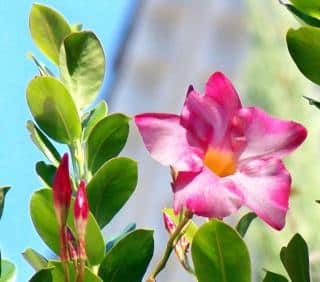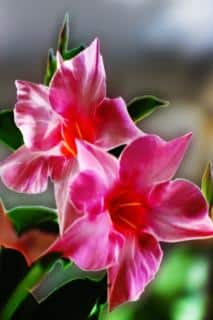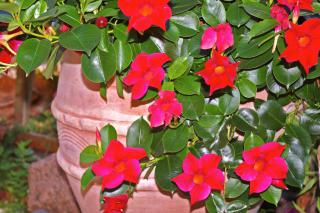

Dipladenia is a richly blooming, trailing or hanging vine that thrives in bright conditions and rewards good care with months of flowers.
Main Dipladenia facts
Latin name – Mandevilla sanderii; Mandevilla boliviensis
Family – Apocynaceae
Type – shrub, hanging vine | Length – up to 10 ft (3 m)
Exposure – well-lit (avoid harsh midday sun indoors)
Soil – well-drained, rich potting mix
Foliage – evergreen | Flowering – summer (often spring to fall under glass)
Caring for this plant—from planting to pruning and including watering—will give you magnificent flowers in summer. Follow our advice and your Dipladenia will bloom beautifully!
Dipladenia is typically grown as an indoor plant in temperate climates. In cold regions it can be set outdoors as an annual after frost, or overwintered indoors.
If potted, plan to repot every 1–2 years, preferably in spring. The nursery container is usually too small for more than one season—repot just after the main bloom flush.

Native to South America, Dipladenia thrives with warmth (≥ 68°F / 20°C) and bright light.
Regular deadheading (removing spent blooms) encourages more flowers.
Propagation is easiest from stem cuttings (late spring to summer). Layering also works but takes longer.
Dipladenia prefers roots on the slightly drier side versus soggy. Avoid letting the root ball bone-dry, especially in heat.
In winter/dormancy, reduce greatly: about once every two weeks with small amounts, or not at all if naturally cool and humid.

Indoors, choose a very bright spot, avoiding direct midday sun through windows.
Potted dipladenia appreciates high humidity. Set the pot on a tray of moist gravel or clay pebbles (without the pot sitting in water) to boost ambient moisture.
Typical bloom runs from March to November under warm, bright conditions. After flowering, winterize the plant in a cooler but well-lit room.
Often due to cold exposure or irregular watering.
Likely scale insects (cottony masses or sticky residue).
Symptoms of spider mites in hot, dry air.

Native to tropical Americas, dipladenia is a sub-group of Mandevilla and a relative of oleander. It flowers abundantly for months with large, funnel-shaped blooms. Left to its natural habit, it trails and cascades; with support, it can be trained to climb.
Because of its tropical origins, greenhouses or bright rooms with high humidity suit it best. Indoors, mist regularly with soft water and use techniques to increase ambient humidity.
Use hanging baskets or tall planters to showcase cascading blooms. Feed lightly every 2–3 weeks during the blooming period to maximize flower count and size.
Read also:
I purchased a Rio Dipladenia a couple of months ago and have it in a 10″ pot indoors. It has been a beautiful, wonderful, plant. Beginning about a month ago it about 15 of the stems became like a vine, (continuing from tips of stem), and they extend several feet above the plant. These vines have a few very small leave/s about ever 6″ to the tips. They attach to the other new vines and tightly wrap themselves around each other. A few of these vines have very small buds. Should I clip these vines off? Can they be transplant? Being indoors, I do not have a trellis for them to climb on.
Just bought a Rio dipladenia. I Repotted it and watered it 2 days
ago and it’s already dry. I read that they can withstand water for a while. With that said, when can I water it again and how often ?
Hi Barbara! Yes, dipladenia can go for a short while without water in the sense that it’s better to underwater than to overwater. However, especially in pots, it doesn’t mean you should treat it as a cactus. Best is to dip your finger near the side of the pot and if it’s dry down an inch (2-3 cm), give it a little water. Also, pay attention to signs like sagging or slightly wilted leaves, that’s a good sign you’ve waited just a day too long. Next time, just water a day earlier and it’ll be perfect!